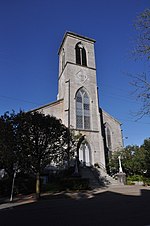John A. Coleman Catholic High School
1966 establishments in New York (state)Catholic secondary schools in New York (state)Educational institutions disestablished in 2019Educational institutions established in 1966Schools in Ulster County, New York
John A. Coleman Catholic High School was a private, Roman Catholic high school in Hurley, New York. It was under the control of the Roman Catholic Archdiocese of New York until 2001. From its inception in 1966 until its closing on August 31, 2019, Coleman Catholic educated students in grades 9–12.
Excerpt from the Wikipedia article John A. Coleman Catholic High School (License: CC BY-SA 3.0, Authors).John A. Coleman Catholic High School
Hurley Avenue, Town of Ulster
Geographical coordinates (GPS) Address External links Nearby Places Show on map
Geographical coordinates (GPS)
| Latitude | Longitude |
|---|---|
| N 41.933055555556 ° | E -74.043333333333 ° |
Address
John A Coleman Catholic High School
Hurley Avenue 430
12443 Town of Ulster
New York, United States
Open on Google Maps







